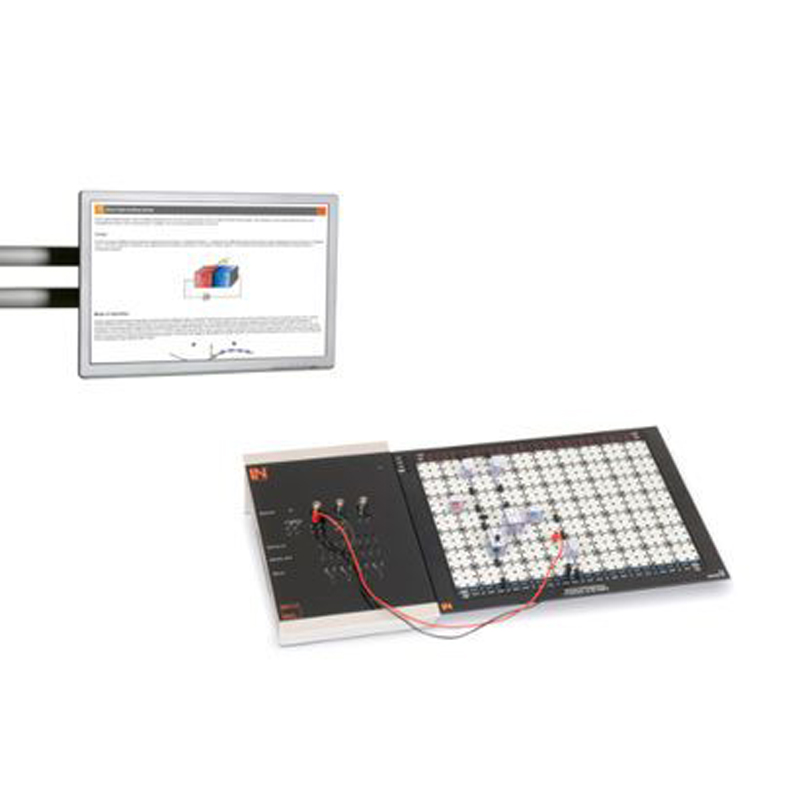
Fundamentals of Automotive Electronics with Elotrain
Part No.: MPLCNL-Fundamentals-of-Automotive-Electronics-with-EloTrain
Experiments specially crafted to reflect usage in vehicles make it possible to understand this vast topic in a simple way.
產品介紹
Fundamentals of Automotive Electronics with EloTrain
The increasing importance of electrical and electronic equipment in vehicles is making it essential to learn the fundamentals of electronics in a practical, hands-on manner. Experiments specially crafted to reflect usage in vehicles make it possible to understand this vast topic in a simple way.
List of Articles
Course, EloTrain 8: Fundamentals of Automotive Electronics
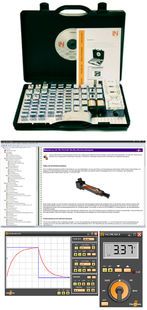
The EloTrain course provides the perfect introduction for students to the world of electrical engineering. All the necessary fundamentals are conveyed by simple and visually memorable means, always retaining the relevance to the automotive mechanics.
The course covers the following topics:
- Introduction to electrical engineering (current, voltage, electrical resistance)
- Use of Ohm's law
- Thorough understanding of different varieties of circuit (serial, parallel, mixed)
- Voltage dividers
- Electrical resistors (ohmic resistance, LDRs, thermistors)
- Potentiometers
- Diodes (LEDs, Zener diodes, standard diodes)
- Capacitors
- Coils and relays
- Complex components such as bipolar and unipolar transistors (field effect transistors)
Theory is conveyed by means of an easily understood section of text concentrating on the key aspects, as well as multiple pictures and professional animations. The knowledge imparted in this way is then checked in various tests and then further enhanced by practical experiments.
In the latter, one of the most important parts of the training is the use of the key measuring instruments (oscilloscopes, multimeters), another is the use of experiments to analyse the features and functioning principle of the individual components. The highlight of such sections is a special automotive experiment, in which a direct link is made between vehicle technology and the component being studied. That means that an affinity with motor vehicles is engendered in the trainees from day one. The course features the following automotive experiments:
- Wiring of headlights
- Brake light with junction resistance
- Bridge circuit for rail pressure sensor
- Determination of engine and air intake temperatures
- 6-pulse rectification in an alternator
- Simulation of indicator control using relays
- Interior lighting (using a transistor as a switch)
- DC/AC conversion for HID lights
- Simulation of a single-spark ignition coil
- Switching via relays (rear fog lamp)
The EloTrain course offers an introduction into the worlds of electronics and electrical engineering suitable for any age groups, which can provide trainees with all the all the knowledge they require in this area to proceed with more advanced training. Such knowledge is of vital importance, particular in an age in which vehicles are becoming more and more electrified.
Additionally Required
The UniTrain-I system is a computer-based training and experimentation system for vocational and further training and education in the areas of basic and advanced electrical engineering and electronics. Its multimedia courses combine cognitive and hands-on (haptic) training units into a comprehensive unified concept, specifically enabling students to acquire skills in the handling of equipment. Starting with basic courses and advancing to cover a huge variety of electrical engineering and electronics topics, a wide range of multimedia courses is available for study in school or in professional and advanced training courses. The UniTrain-I system is completely self-contained and can be used anywhere at any time. The multimedia learning environment the system provides high degrees of motivation, and maximum learning effectiveness in laboratories, at work or at home. It thus becomes a guarantor for effective and efficient study. Access to the multimedia courses and control of virtual instruments and experiment hardware is provided by LabSoft, the system's open experiment platform. The courses teach the theoretical building blocks and provide experiments to be carried out using the course-specific experiment hardware. The intelligent measurement interface supplies the analog and digital measuring and control I/O and represents, in combination with the system's virtual instruments, a high quality item of laboratory equipment. In addition, students' progress can be monitored and electronically documented on the basis of fault finding experiments with faults simulated by the hardware as well as tests of knowledge. The electrical and electronic circuits needed for the experiments are connected to the system with the aid of an Experimenter module.
UniTrain Interface with Virtual Instruments (Basic VI)
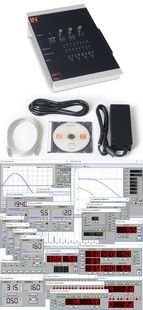
The UniTrain Interface is the central unit of the UniTrain system. It incorporates all inputs and outputs, switches, power and signal sources and measurement circuitry needed to perform experiments. The Interface is controlled via the connected PC.
Equipment:
- 32-bit processor with storage memory for measurements
- USB interfaces, transfer rate 12 Mbits/s
- WLAN/WiFi interface, 2.4 GHz, IEEE 802.11 b/g/n
- Simultaneous connection of any number of Experimenters via serial bus system
- High-quality designer casing with aluminium feet and surface-hardened Plexiglas front panel
- Suitable for accommodating in training panel frames for DIN A4 training panels
- Designed for connection of 2-mm safety measuring leads
- Multi-coloured LEDs for displaying status
- Adjustable analog output, +/-10 V, 0.2 A, DC – 5 MHz, via BNC and 2-mm sockets
- 4 Analog differential amplifier inputs with 10 MHz band width, safe for voltages up to 100 V, sampling rate 100 mega samples, 9 measuring ranges, memory depth 4 x 8 k x 10 bits, inputs via BNC (2 inputs) or 2-mm sockets (4 inputs)
- 2 Analog inputs for current measurement, overcurrent-protected up to 5 A, sampling rate 250 kilo samples, 2 measuring ranges, resolution 12 bits, connection via 2-mm sockets
- 3 variable analog outputs +/- 20V, 1 A, DC-150 Hz (requires CO4203-2B)
- 16-bit digital signal output, of which 8 bits are accessed via 2-mm sockets, TTL/CMOS, clock frequency 0 – 100 kHz, electric strength +/- 15 V
- 16-bit digital signal input, of which 8 bits are accessed via 2-mm sockets, memory depth 16 bit x 2 k, TTL/CMOS, sampling rate 0 – 100 kHz, electric strength +/- 15 V,
- 8 Relays, 24 V DC/1 A, of which 4 are accessed via 2-mm sockets
- Dimensions: 29.6 x 19 x 8.6 cm
- External power supply with wide range input 100-264 V, 47-63 Hz, output 24 V / 5 A
- Weight (including power supply): 2.1 kg
Virtual instruments (meters and sources):
- 2 x Voltmeter VIs, 2 x Ammeter VIs: AC, DC, 9 ranges, 100 mV to 50 V, true RMS, AV
- 1 x Power meter, 9 ranges, 100 mV to 50 V
- 1 x VI with 8 relays, 1 x Multimeter VI: multimeter display (optional LM2330, LM2331 or LM2322) in LabSoft
- 1 x 2-channel ammeter VI: AC, DC, 2 ranges, 300 mA and 3 A, TrueRMS, AV
- 1 x 2-channel voltmeter VI: AC, DC, 9 ranges, 100 mV to 50 V, TrueRMS, AV
- 1 2-/4-channel oscilloscope: band width 10 MHz, 25 time ranges, 100 ns/div to 10 s/div, 9 ranges 20 mV/div to 10 V/div, trigger and pre-trigger, XY and XT modes, cursor function, addition and multiplication function for 2 channels
- 1 x VI Spectrum Analyzer: 9 voltage ranges 100 mV to 50 V, input frequency range 3 Hz to 1 MHz, time domain display
- 1 X VI Bode-Plotter: 9 voltage ranges 100 mV to 50 V, frequency range 1 Hz - 5MHz, time domain display and locus diagram
- 1 x Adjustable DC voltage VI 0 - 10 V
- 1 x Function generator VI: 0.5 Hz - 5 MHz, 0 - 10 V, sine, square, triangular,
- 1 x Arbitrary generator VI, 1 x Pulse generator VI
- 1 x VI with 16 digital outputs, 1 x VI with 16 x digital inputs, 1 x VI with 16 digital input/outputs. Display modes: binary, hex, decimal and octal numerals
- 1 x Three-phase power supply VI, 0 - 150 Hz, 0 - 14 Vrms, 2 A (requires CO4203-2B)
- 1 x Adjustable DC power supply VI, 3 x (-20 V - +20 V), 2 A (requires CO4203-2B)
- 1 x Three-phase power supply VI with additional phase-shift and clock rate adjustment (requires CO4203-2B)
Includes:
- Interface
- Power supply
- Power lead
- USB cable
- CD with basic software
- Operating manual
System requirements:
- Personal computer with Windows Vista, Windows 7, Windows 8, Windows 8.1, Windows 10 (32 or 64 bit)
- CD-ROM drive for installing software
- USB port for connection to Interface
EloTrain Set of Connection Cables and Plugs for 2mm System
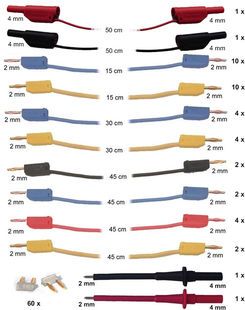
Measuring lead and plug set, 2 mm-system, consisting of:
- 10 measuring leads, 2 mm, 15 cm, blue
- 4 measuring leads, 2 mm, 30 cm, blue
- 10 measuring leads, 2 mm, 15 cm, yellow
- 4 measuring leads, 2 mm, 30 cm, yellow
- 2 measuring leads, 2 mm, 45 cm, black
- 4 measuring leads, 2 mm, 45 cm, red
- 2 measuring leads, 2 mm, 45 cm, blue
- 2 measuring leads, 2 mm, 45 cm, yellow
- 1 safety measuring lead, 4 mm, 50cm, black
- 1 safety measuring lead, 4 mm, 50cm, red
- 1 safety probe 2 mm, black
- 1 safety probe 2 mm, red
- 60 jumpers 2 mm /7.5 mm, white
- Contact information: max. 50 V, max 10 A
EloTrain Experimenter
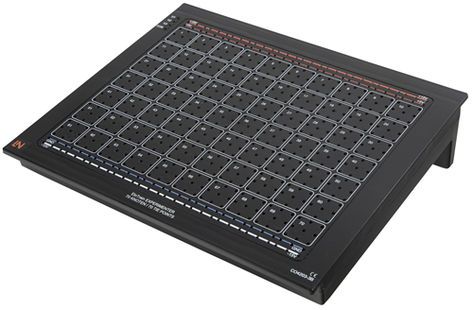
EloTrain Experimenter for 2-mm plug-in component system to be linked to UniTrain-I Interface. 70 nodes allow for easily understood circuit set-ups in a compact space. Circuits are built by inserting the plug-in modules between nodes on the board. Connections between nodes can be made using 2-mm or 7.5-mm jumpers.
- Links to a UniTrain-I Interface
- Fixed and variable power supply connections via 2-mm sockets
- For use with 2-mm plug-in components
- 70 nodes each with 9 x 2-mm sockets
- 7.5-mm grid for 2-mm sockets
- 4 bus lines for power supply (+15 V,+5 V, -15 V, earth) via 2-mm sockets
- Outputs for variable three-phase power supply
- Ergonomic working thanks to console housings
- Suitable for accommodating in training panel frames for DIN A4 training panels
- Contact loading: max. 10 A
- Dimensions: 363 x 297 x 85 mm (WxDxH)
- Weight: 1.7 kg
Additionally Recommended
UniTrain Storage Case for One System
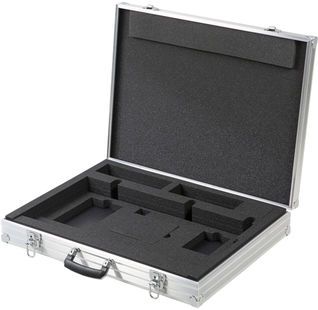
- Sturdy aluminium case with moulded foam block to accommodate a complete UniTrain system (without equipment)
- Capable of accommodating 1 Interface, 2 Experimenters, 1 power supply as well as cables and smaller accessories
- Lockable padlock; stable padlock hinge
- Colours: aluminium, black, chrome
- Dimensions: 610 x 480 x 100 mm
- Weight: 4,6 kg